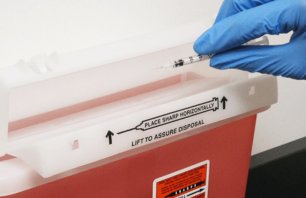Occupational Safety and Health Administration (OSHA) standards are designed to help employers ensure a safe and healthy work environment. The requirements address a wide range of safety hazards and apply across numerous industries. For healthcare organizations, there are a few OSHA standards that are especially important to understand, including the Bloodborne Pathogens Standard, the Hazard Communication Standard, and requirements around emergency preparedness and response. These regulations highlight substantial risks in the healthcare environment, and compliance with them is critical to preserving worker safety and protecting patients and visitors as well.
What Is the Bloodborne Pathogens Standard?
The Bloodborne Pathogens Standard covers how to safeguard healthcare workers against bloodborne pathogens exposure. Bloodborne pathogens are microorganisms that may be present in blood or other body fluids that can lead to serious disease. The standard applies to any healthcare organization where staff are at risk of exposure. Due to the requirements, healthcare organizations can sometimes struggle to achieve consistent compliance.
To meet these requirements, it is essential to have a detailed exposure control plan that outlines risks, prevention strategies, and response procedures if a worker is exposed. Furthermore, employers should comply with OSHA Training requirements to understand the risks of exposure and how employees are critical to ensuring a safe and healthy working environment. Training should occur as part of orientation and at least annually as a refresher. Should an employee take on new or modified tasks that increase their exposure risk, they should receive supplemental training.
Other topics addressed in the standard include the need to offer preventive immunizations to at-risk employees, the importance of clearly labeling any biohazardous material, and the need to have appropriate recordkeeping procedures in place.
What Information Should Be Included in an Exposure Control Plan?
A written exposure control plan should discuss how to identify those employees who are at risk of being exposed to bloodborne pathogens as part of their jobs and how to protect those employees from exposure. Key protection strategies to cover include: proper training, proactive immunization, physical safeguards, and clear biohazard labeling. Physical safeguards may include: universal and standard precautions, engineering controls, work practice controls, administrative controls, and personal protective equipment (PPE). In some cases, sharps receptacles can be reusable, limiting the waste entering landfills after the waste has been treated.
An exposure control plan should also detail the steps involved in responding to an exposure incident, including: how to document the event, whom to notify, and how to evaluate the incident to uncover and address potential issues to prevent similar occurrences in the future.
Plans should be easily accessible and kept up to date—you should review them at least annually. When creating a plan, you don’t need to start from scratch. Plans created by third-party OSHA experts, like the ones from Stericycle, allow you to start with a basic plan and modify it to reflect your organization’s unique characteristics.
What Is the OSHA Hazard Communication Standard?
The OSHA Hazard Communication Standard covers how employers communicate with their employees about hazardous chemicals they may be exposed to at work to reduce the number of injuries and fatalities as a result. Such materials may include anything from dangerous pharmaceuticals to toxic chemicals. The employer is responsible for complying with OSHA regulations that apply, to help maintain the health and safety in the workplace. First, you must create and maintain a master list of hazardous chemicals used within your facility. Next, you must develop a written hazard communication program that covers how you will inform staff about the identified hazards, including ensuring any labels comply with the globally harmonized system (GHS)—an internationally agreed upon set of labels for health, physical, and environmental hazards. Your program should also address OSHA staff training and the use of safety data sheets (SDS). As with an exposure control plan, you don’t have to start from scratch when developing a hazard communication program. A knowledgeable expert can provide a template that serves as a good starting point.
What Are Safety Data Sheets?
Safety Data Sheets or SDSs are documents that come from chemical manufacturers that outline the properties, risks, handling requirements, and storage practices for hazardous chemicals. OSHA standard requires chemical companies to provide an SDS to any entity who uses a hazardous chemical, such as a healthcare organization. In turn, the healthcare organization must ensure employees can rapidly access the latest SDS for the hazardous chemicals used and stored in their workplace. There are many ways to facilitate access. For example, you may keep your organization’s safety data sheets in a binder, store them electronically, or work with an outside partner like Stericycle to house them online.
What about Emergency Preparedness and Response Requirements?
Emergency Preparedness and Response is not a separate standard but rather a group of requirements that discusses the importance of planning for an emergency, whether the potential event takes the form of a natural or man-made disaster. Your organization should develop detailed plans that outline general preparedness, as well as specific responses to different kinds of disasters, including fire and extreme weather events. One thing to keep in mind when developing these plans is how waste management will be addressed should the regular waste service be disrupted or if there is a rapid increase in the volume of contaminated chemical waste generated. Developing emergency response plans in partnership with a hazardous chemical waste management company can ensure your organization fully analyzes different scenarios and identifies proactive strategies that mitigate risk and support continuous compliance before, during, and after a disaster.
Meeting OSHA requirements can be challenging. By working with a knowledgeable partner that has deep familiarity with the standards, you can be confident your organization is meeting relevant requirements consistently. To learn how Stericycle can be your OSHA compliance partner, go to our OSHA Compliance Hub.



